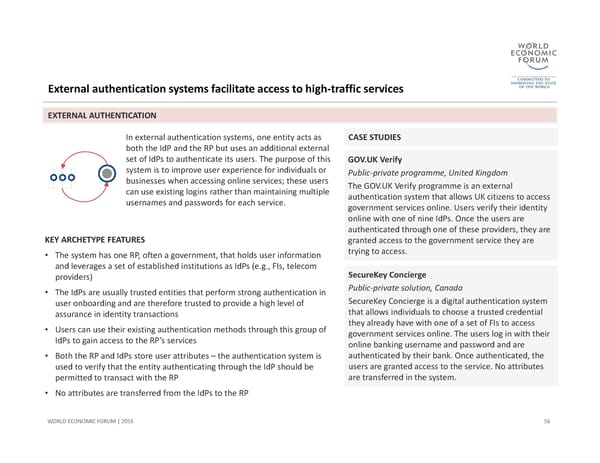External authentication systems facilitate access to high‐traffic services 56 WORLD ECONOMIC FORUM | 2016 GOV.UK Ve r i f y Public‐private programme, United Kingdom The GOV.UK Ve r i f y programme is an external authentication system that allows UK citizens to access government services online. Users verify their identity online with one of nine IdPs. Once the users are authenticated through one of these providers, they are granted access to the government service they are trying to access. KEY ARCHETYPE FEATURES •The system has one RP, often a government, that holds user information and leverages a set of established institutions as IdPs (e.g., FIs, telecom providers) •The IdPs are usually trusted entities that perform strong authentication in user onboarding and are therefore trusted to provide a high level of assurance in identity transactions •Users can use their existing authentication methods through this group of IdPs to gain access to the RP’s services •Both the RP and IdPs store user attributes –the authentication system is used to verify that the entity authenticating through the IdP should be permitted to transact with the RP •No attributes are transferred from the IdPs to the RP In external authentication systems, one entity acts as both the IdP and the RP but uses an additional external set of IdPs to authenticate its users. The purpose of this system is to improve user experience for individuals or businesses when accessing online services; these users can use existing logins rather than maintaining multiple usernames and passwords for each service. SecureKey Concierge Public‐private solution, Canada SecureKey Concierge is a digital authentication system that allows individuals to choose a trusted credential they already have with one of a set of FIs to access government services online. The users log in with their online banking username and password and are authenticated by their bank. Once authenticated, the users are granted access to the service. No attributes are transferred in the system. EXTERNAL AUTHENTICATION CASE STUDIES
 A Blueprint for Digital Identity Page 56 Page 58
A Blueprint for Digital Identity Page 56 Page 58